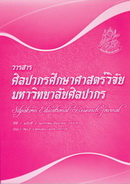การวิเคราะห์พหุระดับตัวแปรที่มีอิทธิพลต่อความฉลาดทางอารมณ์ของนักเรียน ชั้นประถมศึกษาปีที่ 5 สังกัดสำนักงานเขตพื้นที่การศึกษาพิจิตร
บทคัดย่อ
บทคัดย่อ
การวิจัยครั้งนี้มีวัตถุประสงค์ เพื่อศึกษาตัวแปรระดับนักเรียน และตัวแปรระดับโรงเรียนที่มีอิทธิพลต่อความฉลาดทางอารมณ์โดยตัวแปรระดับนักเรียนมี 3 ตัวแปร ประกอบด้วย 1) เพศหญิง 2) ผลสัมฤทธิ์ทางการเรียน และ 3) บรรยากาศในครอบครัว ส่วนตัวแปรระดับโรงเรียน มี 2 ตัวแปร ประกอบด้วย 1) บรรยากาศการเรียนการสอน และ 2) สภาพแวดล้อมในโรงเรียน กลุ่มตัวอย่างในการวิจัยประกอบด้วย นักเรียนชั้นประถมศึกษาปีที่ 5 จำนวน 1,240 คน และครูประจำชั้นประถมศึกษาปีที่ 5 จำนวน 106 คน รวมทั้งสิ้น 1,346 คน จาก 96 โรงเรียน ซึ่งได้มาโดยการสุ่มแบบหลายขั้นตอน เครื่องมือที่ใช้ในการวิจัย เป็นแบบสอบถาม 2 ฉบับ คือ ฉบับที่ 1 เป็นแบบสอบถามสำหรับนักเรียน และฉบับที่ 2 เป็นแบบสอบถามสำหรับครู สถิติที่ใช้ในการวิเคราะห์ข้อมูล ได้แก่ ค่าเฉลี่ย ส่วนเบี่ยงเบนมาตรฐาน ค่าสัมประสิทธิ์สหสัมพันธ์ของเพียร์สัน ด้วยโปรแกรมสำเร็จรูป และการวิเคราะห์พหุระดับ 2 ระดับ ด้วยโปรแกรมสำเร็จรูป HLM (Hierarchical Linear Model) ผลการวิจัยพบว่า 1) ผลการวิเคราะห์ระดับนักเรียน พบว่า เพศ ผลสัมฤทธิ์ทางการเรียนและบรรยากาศในครอบครัวมีอิทธิพลต่อความฉลาดทางอารมณ์ของนักเรียนอย่างมีนัยสำคัญทางสถิติที่ระดับ .05 และ .01 ส่วนค่าเฉลี่ยความฉลาดทางอารมณ์ สัมประสิทธิ์การถดถอยของผลสัมฤทธิ์ทางการเรียน และสัมประสิทธิ์การถดถอยของบรรยากาศในครอบครัวมีความแปรปรวนระหว่างโรงเรียนอย่างมีนัยสำคัญทางสถิติ นอกจากนั้นยังพบว่า สัมประสิทธิ์การถดถอยของเพศ ไม่มีความแปรปรวนระหว่างโรงเรียน โดยตัวแปรอิสระระดับนักเรียนสามารถร่วมกันอธิบายความแปรปรวนของตัวแปรตามได้ร้อยละ 55 2) ผลการวิเคราะห์ระดับโรงเรียน พบว่า บรรยากาศการเรียนการสอน มีอิทธิพลต่อความฉลาดทางอารมณ์ อย่างไม่มีนัยสำคัญทางสถิติ ส่วนค่าเฉลี่ยความฉลาดทางอารมณ์ สัมประสิทธิ์การถดถอยของผลสัมฤทธิ์ทางการเรียน และสัมประสิทธิ์การถดถอยของบรรยากาศในครอบครัวมีความแปรปรวนระหว่างโรงเรียนอย่างมีนัยสำคัญทางสถิติ สำหรับตัวแปรสภาพ แวดล้อมในโรงเรียน เนื่องจากเกิดภาวะร่วมเส้นตรงพหุมีความสัมพันธ์กันสูงกับตัวแปรอิสระด้วยกัน ผู้วิจัยจึงไม่ได้นำตัวแปรดังกล่าวเข้าสู่การวิเคราะห์ โดยตัวแปรอิสระระดับโรงเรียนสามารถร่วมกันอธิบายความแปรปรวนของตัวแปรตามได้ร้อยละ 54
Abstract
The purpose of this research was to study the variables such as students and schools that affect emotional quotients (EQ). For the student level they were categorized into 3 independent variables: 1) female gender, 2) learning achievement, and 3) family environment. For the school level they were categorized into 2 independent variables: 1) learning environment and 2) environment in school. The sample group in this study comprised 1,240 level 5 primary school students and 106 teachers of level 5 primary school students, totalling 1,346 samples from 96 schools obtained by multiple random sampling. The instruments for this study are 2 questionnaires, one for the students and another for the teachers. Data analysis was done through statistics such as mean, standard deviation, Pearson’s correlation coefficients using Statistical Package with multi-level analysis using Hierarchical Linear Model (HLM). The results of the research were as follows: 1) The analysis for the students level found that for the female gender, learning achievement, and family environment have significantly affects the students’ emotional quotient at the .05 level and .01 level, respectively. For the means of emotional quotients, regression coefficient of the learning achievement and that of the family environment were significantly varied among the schools. However, regression coefficients of female gender were not varied among the schools. The student independent variables related to the dependent variable were about 55%. 2) The analysis for the schools level found that learning environment did not have statistical difference on EQ. For the means of emotional quotients, regression coefficient of the learning achievement and the family environment were significantly varied among the schools. For the school environment variable that has high correlation with other independent variable, we did not use them in this analysis. The independent variable of the school level can affect the dependent variable variance about 54%.





